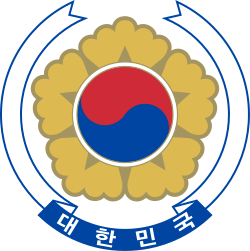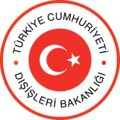South Korea–Turkey relations
 | |
South Korea |
Turkey |
|---|---|
South Korean–Turkish relations are foreign relations between South Korea and Turkey. Turkey has an embassy in Seoul, while South Korea has an embassy in Ankara and a consulate-general in Istanbul. Both countries are members of G20.
History
Early contact can be traced back to antiquity, when the Göktürks had supported ancient Goguryeo, a Korean Kingdom, during their expansion and also assisted them against Han Chinese forces. As both Göktürks and Goguryeo were oppressed by the Tang China, they formed a political, economical, and military alliance.[1][2][3] Göktürk soldiers assisted Goguryeo in many battles, including in the war against Silla, another Korean Kingdom, and Tang China.[4][5][6] Commerce and correspondence was also maintained through the ancient Silk Road after a part of the ancient Oghuz-Turks migrated westward and settled in the lands of Anatolia (today Turkey).[7]
South Korea and Turkey have enjoyed a longstanding relationship marked by strong economic, cultural, diplomatic, and touristic ties.[8] These relations can be largely traced to the formation of the South Korean nation, when Turkey, namely the Turkish Brigade, had supported South Koreans against North Korean forces at the Korean War. Of the 721 Turkish soldiers who fell in the battles, 462 were buried at the "Heroes' Cemetery" in Busan.[9] Based on those mutual gestures and acts of friendship, the relationship between the two nations is often referred as "Korean–Turkish brotherhood" (Turkish: Kore–Türk dostluğu; Korean: 한국 – 터키 우정).[10]
Economic relations
In 2013, both countries entered into a free trade agreement.[11]
Military cooperation
Altay tank, a newly military tank of the Turkish Armed Forces, was supported by Hyundai Rotem with technical support and assistance.[12]
Sports
After the 3rd place match at the 2002 FIFA World Cup, South Korean and Turkish football players celebrated together and showed exemplary images of friendship and fair play. The flags of both nations were seen side by side on the stands and both teams' players saluted the crowds arm in arm, creating a friendly atmosphere that continued even long after the match.[13]
References
- ↑ Korea & Turkey
- ↑ Gyebaek (계백, 階伯) (d. 660)
- ↑ Tarihin En Şaşırtıcı Savaşı: Salsu Zaferi ve Türk-Kore Dostluğunun Temelleri
- ↑ Korean History in Maps
- ↑ Turkish-Korean brotherhood
- ↑ Second Forum of “Gokturk and Goguryeo Relations” in Seoul
- ↑ Turkish art shines light on ties with Korea
- ↑ Turkish art shines light on ties with Korea
- ↑ Turkey and South Korea: Blood brothers for 60 years
- ↑ Turkey, Korea Blood Brothers
- ↑ http://www.invest.gov.tr/en-US/infocenter/news/Pages/020315-turkey-south-korea-expand-fta.aspx
- ↑ http://www.defenseindustrydaily.com/turkey-signs-deal-with-s-korea-for-altay-tank-project-05012/
- ↑ Turkish media says thanks

